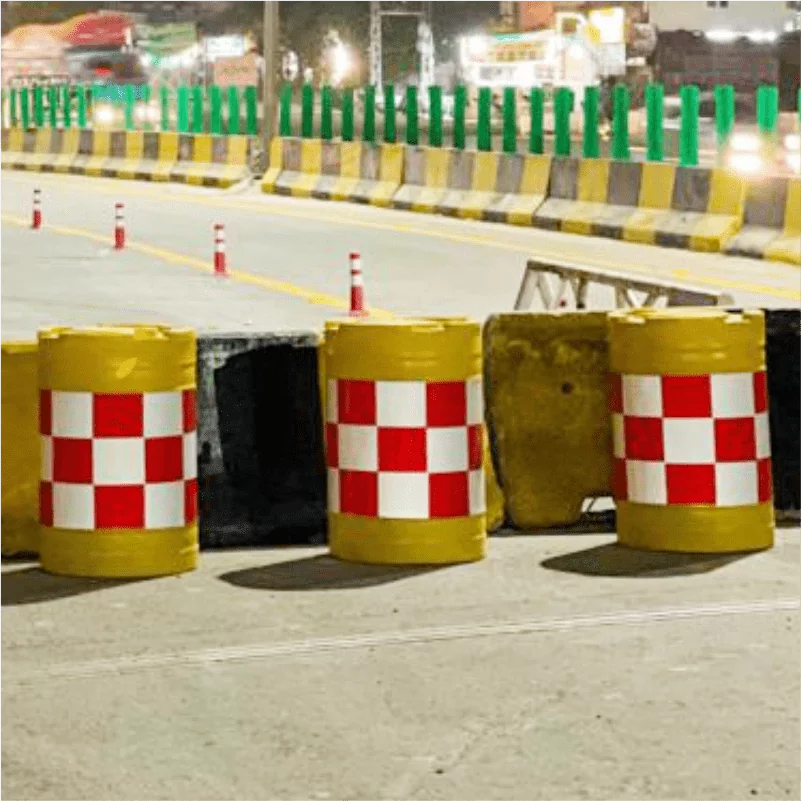Think about the roads you travel on every day. You might have witnessed road safety barriers that quietly keep us safe while we are driving or walking. These barriers are not just random fences or walls but play the role of guardians that protect us from accidents and major mishaps.
In this blog, we will take a closer look at these special barriers. We will help you learn about the different types of road safety barriers and why they are so important for everyone’s safety.
These barriers might not look fancy, but they do a big job of making sure we all stay safe on the roads. So let’s get started to learn further about these barriers.
What are Road Safety Barriers?
Before moving further, let us first help you know what road safety barriers actually are? If ypu too are looking to know about it then here is the answer for you!
Road safety barriers are structured barriers that are specifically designed for road safety. These barriers are strategically placed along roads, highways, and streets to enhance safety for drivers, passengers, pedestrians, and nearby properties.
In short, road safety barriers serve as a protective measure, aiming to minimize the impact of accidents and prevent vehicles from leaving the roadway or crossing into opposing traffic lanes.
Major Use of Road Safety Barriers
Safety barriers serve the purpose of preventing ‘out of control’ vehicles from:
- Departing the road and colliding with roadside dangers, such as slopes (referred to as roadside barriers).
- Intruding into the path of oncoming vehicles (commonly known as median barriers).
These barriers are engineered to redirect vehicles and, importantly, have a lesser impact severity compared to the potential dangers present along the roadside. Various types of safety barriers exist, each containing distinct systems with their specific performance characteristics.
Different Types of Road Safety Barriers and Their Uses
Here are some different types of road safety barriers that are designed for road safety:
Guardrails
Metal barriers, known as Guardrails are placed along the edge of roads to prevent vehicles from veering off into dangerous areas like steep slopes or oncoming traffic.
Concrete Barriers
Sturdy walls or blocks made of concrete that serve as a physical barrier to prevent vehicles from crossing over into opposing lanes or from colliding with roadside hazards.
Cable Barriers
Flexible barriers made of steel cables or wires installed along medians or between lanes to absorb impact and prevent vehicles from crossing into oncoming traffic.
Crash Cushions
Specifically designed structures placed at the ends of barriers or in hazardous areas to absorb the impact of a collision, reducing damage and injuries.

The primary goal of road safety barriers is to improve road safety by reducing the severity of accidents, minimizing injuries, and preventing collisions with potentially dangerous obstacles or vehicles in adjacent lanes.
They are strategically installed based on factors like traffic volume, speed limits, road geometry, and potential hazards to provide effective protection.
Know the Importance of Road Safety Barriers
As we have discussed before road safety barriers play a crucial role in ensuring safety on roads for both drivers and pedestrians. Their importance stems from several key reasons:
Accident Prevention
They help prevent accidents by stopping or redirecting vehicles that might otherwise crash into roadside obstacles or enter opposing lanes. This is how these barriers are important in reducing the severity of potential collisions.
Protection for Road Users
Barriers provide a protective barrier between vehicles and hazards like steep slopes, trees, utility poles, or other structures. As a result, safeguards drivers, passengers, and pedestrians from serious harm.
Minimize Injury Severity
By absorbing impact or redirecting vehicles, these barriers can significantly reduce the severity of injuries sustained in accidents, potentially saving lives.
Traffic Management
They aid in managing traffic flow and reducing the risk of pile-ups or accidents caused by vehicles straying from their lanes or losing control.
Infrastructure Protection
Road safety barriers also protect road infrastructure, minimizing damage to roads, bridges, and other vital components. This in turn reduces repair costs and road closure durations.
Legal and Liability Aspects
Properly installed barriers can mitigate legal liability by demonstrating that reasonable measures were taken to enhance road safety.
Three Different Types of Road Safety Barriers and How They Serve in Road Safety
Want to know more about these road safety barriers and how are they helpful? So here you go, we are introducing three different types of road safety barriers and their role in managing safety of the roads.
Concrete Road Safety Barriers
Concrete road barriers, suitable for short or long-term rental, offer robust and temporary protection, especially beneficial for safeguarding construction workers on job sites. These barriers are easily repairable and replaceable and are adaptable to various configurations.
These barriers are also known for effectively shielding against unexpected intrusions or flying debris. Their versatility allows placement in large construction areas, providing reliable crash protection, tested for safety assurance.
Water Filled Road Barriers
Water-filled road barriers are made of lightweight bright orange plastic. They offer quick installation and easy transportation despite their lighter weight compared to concrete barriers. While less hefty, they remain effective, causing minimal damage to vehicles upon impact due to their smooth surfaces.
These barriers’ visibility and color aid in redirecting traffic and marking detours for slower-speed roads, typically under a fifty-kilometer-per-hour limit. For higher-speed roads, alternative barrier options are considered.
Steel Road Barriers
Steel road barriers offer heavy-duty protection for roads up to 100 kilometers per hour, excelling in shock absorption. They safeguard construction sites, pedestrians, and drivers by providing crash prevention and traffic redirection.
These barriers also come in innovative options like the HighwayGuard which are highly maneuverable, fitting curved lines, and equipped with noise-reducing features. With added wheelsets for adjustable access, this system is lighter, safer, and more cost-effective than other steel barriers, maintaining top safety ratings and efficient manufacturing.
The Effects of Road Safety Barriers
The impact of a road safety barrier becomes evident in its ability to shield drivers and pedestrians from harm. A well-designed barrier significantly lowers the risk of severe injuries or fatalities during accidents by absorbing vehicle impact and guiding it away from pedestrians and other vehicles.
Moreover, road safety barriers serve as a visual reminder for drivers to adhere to road regulations. For instance, guardrails separating lanes discourage dangerous maneuvers like crossing into oncoming traffic, ultimately reducing collisions and improving road safety.
Additionally, the presence of these barriers influences driver behavior psychologically. Drivers tend to exercise more caution when barriers are visible, knowing they serve as protective measures. This increased awareness helps minimize accidents and promotes safer driving practices on the road.
Road Safety Barriers by Eastern Highway
At Eastern Highway, we understand the paramount importance of road safety. Our commitment lies in providing cutting-edge road safety equipment and management solutions, including a comprehensive range of road safety barriers. These barriers, meticulously designed and implemented, embody our dedication to ensuring safer journeys for everyone on the road.
So, get ready to partner with Eastern Highway for a safer tomorrow on the roads, where every journey counts.









